二叉树先序、中序、后序及层次四种遍历
包括前序、中序、后序、层序,前中后右两种写法,层序只用了 BFS。
前序
称之为前序是因为前序遍历时候,rot 在左子树和右子树之前:[root, left, right],以下图为例:
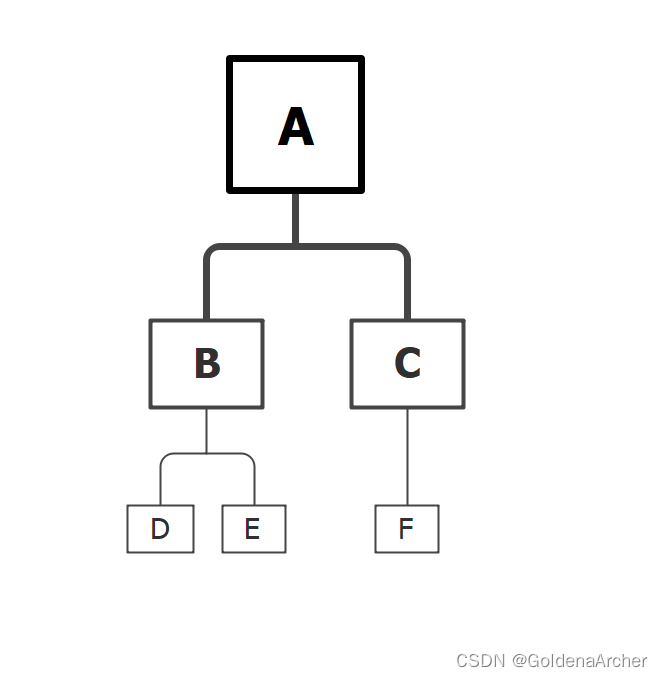
前序遍历的顺序为:[A, B, D, E, C, F],其遍历过成为:
-
从根部开始,此时访问的结点为 A

输出的结果为:
[A] -
从左子树开始访问,此时访问的结点为 B
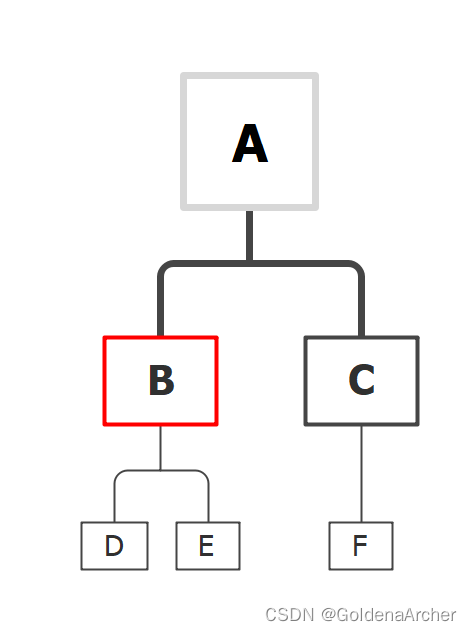
输出的结果为:
[A, B] -
重复步骤,继续访问结点 B 的左子树
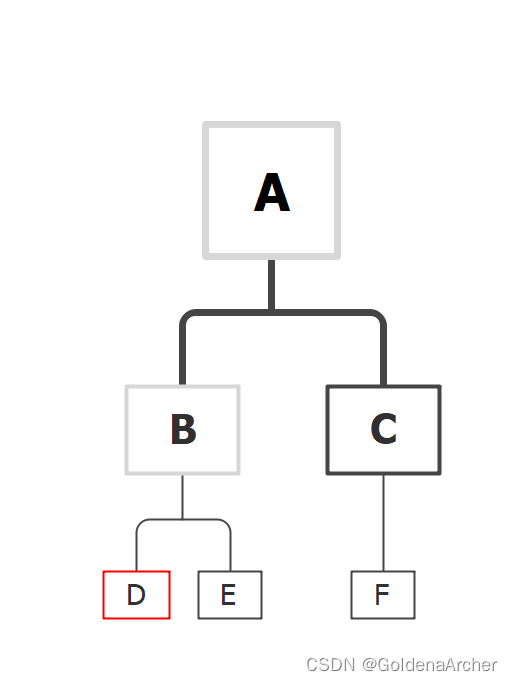
输出的结果为:
[A, B, D] -
没有更多的左子树可以访问,现在开始访问右子树

输出的结果为:
[A, B, D, E] -
当前左子树访问完毕,开始访问右子树
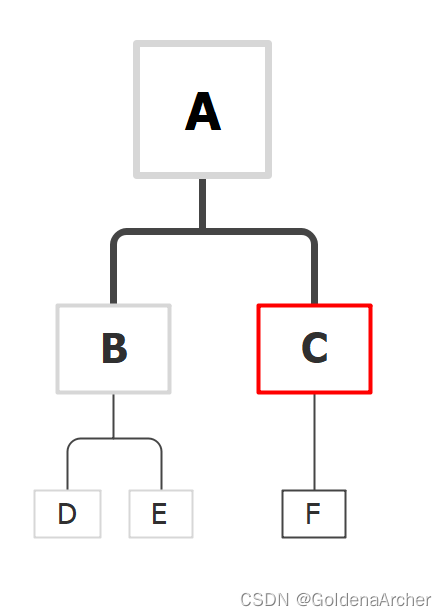
输出的结果为:
[A, B, D, E, C] -
重复该步骤,完成当前树的访问
前序实现
前序递归
对于树的遍历来说,递归地实现方法是最简单的,只要按照:
- 将当前值输出
- 访问左子树
- 访问右子树
这样的逻辑去实现即可:
const preorderRecur = (root) => {
if (!root) return [];
return [root.val, ...preorder(root.left), ...preorder(root.right)];
};
前序遍历
遍历可以使用 stack 的方法去实现,因为 stack 的数据结构是 FILO,所以就可以保证每次获取上一个的结点都是最近的树。
依旧以上面的图为例,下面简单的描述一下每次访问时 stack 中包含的节点:
-
[A]
这时候只有根结点
-
[C, B]
这时候栈中存在的是根结点的左右两个结点,注意后将左结点压入栈中,这样能够保证左结点可以最先跳出
-
[C, E, D]
弹出一个最近的结点,并重复步骤将弹出结点的子节点压入 stack 中
-
重复该步骤一直到栈为空
实现如下:
const preorder = (root) => {
const stack = [root],
res = [];
while (stack.length) {
const node = stack.pop();
res.push(node.val);
if (node.right) stack.push(node.right);
if (node.left) stack.push(node.left);
}
return res;
};
中序
称之为前序是因为前序遍历时候,rot 在左子树和右子树中间:[left, root, right],依旧以上面的图为例

递归的实现依然比较简单:
const inorderRecur = (root) => {
if (!root) return [];
return [...inorderRecur(root.left), root.val, ...inorderRecur(root.right)];
};
前序遍历的顺序为:[D, B, E, A, F, C],迭代过程中会使用一个 stack 去保存结点。
-
[]
此时虽然访问到了 A,但是因为左子树还没有完成所有的遍历,现在不能够将当前结点输出
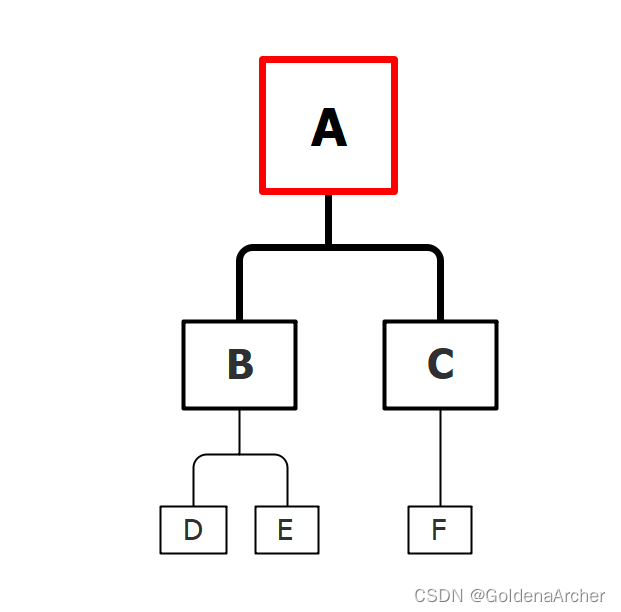
-
[]
这时候虽然访问到了 B,但是左子树依旧没有完成遍历,所以还不能够将当前值输出

-
[D]
此时访问到了 D,因为这是最后一个左子树,因此可以将值输出
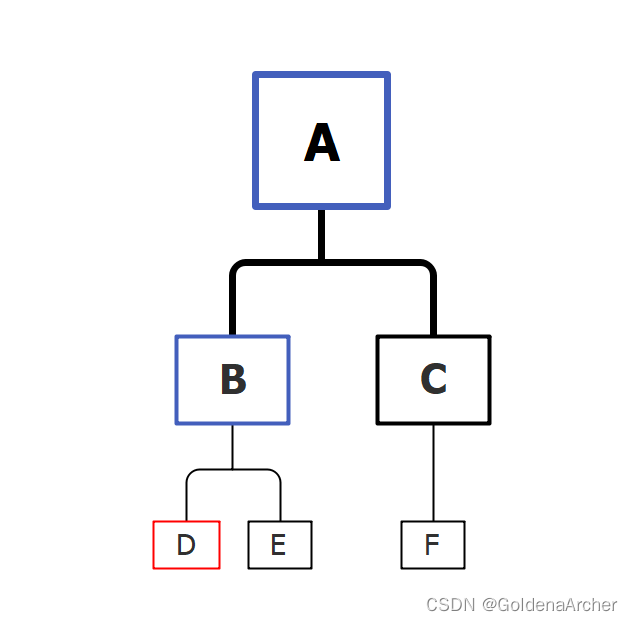
-
[D, B, E]
此时正在访问的就是 E,此时 E 也没有子节点,因此可以将 B 和 E 的值输出
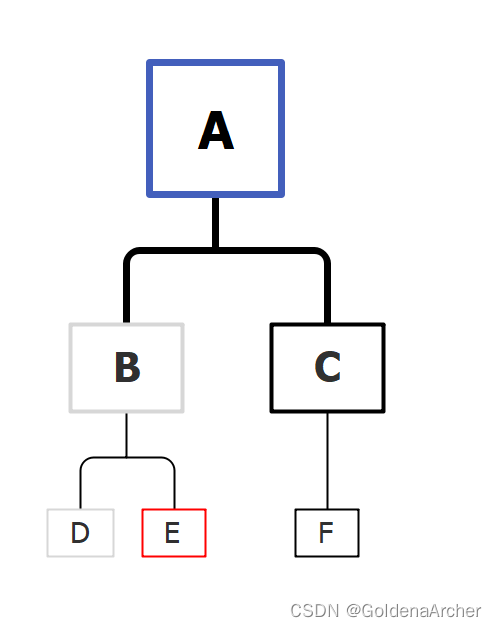
-
[D, B, E, A]
此时访问的结点是 C,因为 C 是 A 的右子树,因此按序 A 也可以进行输出
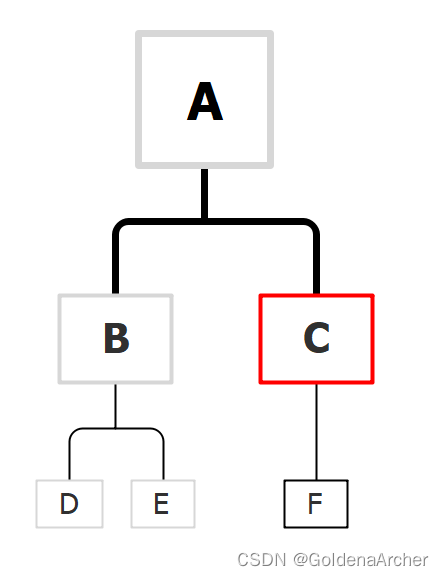
-
[D, B, E, A, F, C]
现在访问的是最后一个结点 F,F 在 C 的左子树,因此需要优先输出
遍历的方法实现如下:
const inorder = (root) => {
let node = root;
const stack = [],
res = [];
while (true) {
if (node) stack.push(node);
while (node?.left) {
stack.push(node.left);
node = node.left;
}
if (!stack.length) break;
node = stack.pop();
res.push(node.val);
node = node?.right;
}
return res;
};
使用上面的代码过一遍一样的树:
-

stack 为:
[A]此时还在第二个循环
while (node?.left)中 -

stack 为:
[A, B]此时还在第二个循环
while (node?.left)中 -

stack 为:
[A, B, D]此时结束第二个循环,走入循环下面的逻辑。
stack 中的最后一个值取出并进行输出,**最重要的一点是:**需要将
node指向node的右子树 -
stack 为:
[A, B]当前的值为
D的右子树,也就是null,因此不会进入while (node?.left)循环中随后依旧取出 stack 中的最后一个结点,输出,将
node指向该结点的右子树,即 E -

stack 为:
[A]当前值为 E,因为 E 没有左右子树,因此不会进入
while (node?.left)循环中,并且最后会将node指向 null -
此时 stack 的长度依然为 1,node 指向 null,因此会执行
node = stack.pop();这一行。A 的值会被输出,同时 node 指向 A 的右子树,也就是 C
-

C 不是一个空置,所以会在
while (true)中的第一行被压入 stack 中,此时的 stack 值为[C]C 也有左子树,因此会进入循环体将所有的左子树压入 stack 中
最终在结束
while (node?.left)循环后,stack 的值为[C, F] -
最后重复步骤,完成遍历
后序
递归的写法依旧比较简单:
const postorderRecur = (root) => {
if (!root) return [];
return [
...postorderRecur(root.left),
...postorderRecur(root.right),
root.val,
];
};
后序遍历的实现就是将 root 的值放在最后输出,也就是说只有将左子树和右子树全都遍历完成后,才将当前结点的值进行输出。
迭代的写法如下:
const postorder = (root) => {
let curr = root;
const stack = [],
res = [];
do {
if (curr) {
stack.push(curr);
curr = curr.left;
} else {
let temp = stack[stack.length - 1].right;
// only has left child tree
if (temp === null) {
temp = stack.pop();
res.push(temp.val);
while (stack.length && temp === stack[stack.length - 1].right) {
temp = stack.pop();
res.push(temp.val);
}
} else {
curr = temp;
}
}
} while (stack.length);
return res;
};
以同一张图为例:
-

此时访问的结点是 A,A 的值不为 null,所以 stack 的值为
[A] -

此时访问的结点是 B,B 的值不为 null,所以 stack 的值为
[A, B] -

此时访问的结点是 D,D 的值不为 null,所以 stack 的值为
[A, B, D] -
此时访问的是
D.left,这是一个空值,会走到第一个else里去。else中的temp指向的就是D.right,D 并不存在右子树,这也代表了 D 的左右子树都已经访问完毕,因此将值输出即可此时 stack 中的值为
[A, B] -
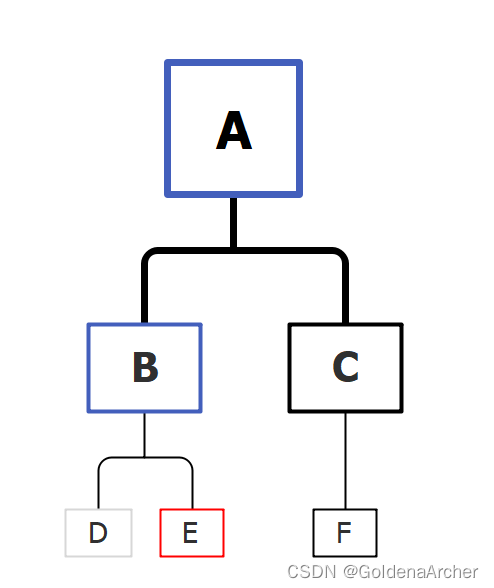
这个循环中会将
temp指向B的右子树,此时右子树存在,curr的指向改为 E,再一次重复循环此时 stack 的值为
[A, B, E] -
E 均不存在左右子树,可以进行输出
此时 stack 的值为
[A, B]这里在
if (temp === null)的循环体即:
// 在这里 temp 是 E // stack 是 [A, B] // E 是 B 的右树,这时候在这个循环体内进行迭代,一直回溯所有的右子树 while (stack.length && temp === stack[stack.length - 1].right) { temp = stack.pop(); res.push(temp.val); }while循环结束时如下: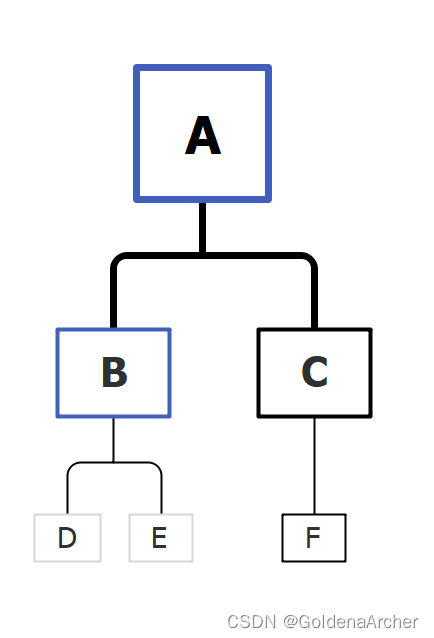
这个循环跑完后,stack 的值为
[A], curr 为 null -
新的循环中,curr 会指向
A.right,然后开始右子树的遍历
总体来说,后序遍历是最麻烦的遍历方式。
不过在迭代写法中的后序遍历,会不断地遍历所有的子树,因此空间复杂度为 O ( h ) O(h) O(h),换言之,后序遍历也可以用来查找最深子树。
最后,把前序遍历的结果进行翻转之后,其实也能获得后序遍历的结果:
var postorderTraversal = function (root) {
if (!root) return [];
const res = [];
const stack = [root];
while (stack.length) {
const node = stack.pop();
res.push(node.val);
if (node.left) stack.push(node.left);
if (node.right) stack.push(node.right);
}
return res.reverse();
};
层序
层序其实就是比较简单的 BFS 了。
var levelOrder = function (root) {
if (root === null) return [];
const queue = [root];
const res = [];
while (queue.length > 0) {
let size = queue.length;
const currDegree = [];
for (let i = 0; i < size; i++) {
const node = queue.shift();
currDegree.push(node.val);
if (node.left) {
queue.push(node.left);
}
if (node.right) {
queue.push(node.right);
}
}
res.push(currDegree);
}
return res;
};